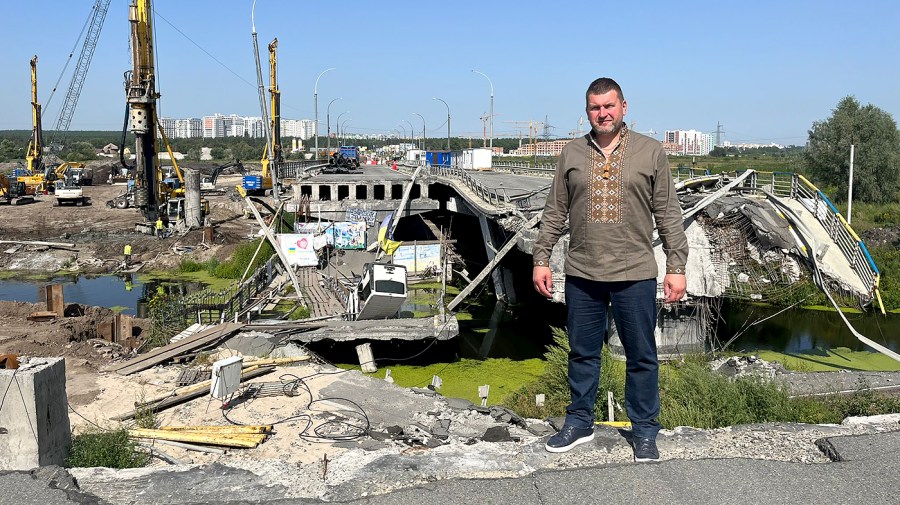Ukraine puts captured Russian war machines on display at muted Independence Day
KYIV, Ukraine — It was a muted Independence Day in Ukraine’s capital city, where the population generally laid low amid threats of Russian attacks six months into a brutal war that has left tens of thousands dead.
The normal jammed traffic was slower, as Ukrainians paid heed to warnings of possible strikes. Air raid sirens sounded throughout the day and into the evening, a reminder that Russian missiles still threaten the country.
A few souvenir hawkers were out on nearly empty sidewalks — some with hiked prices despite the lack of crowds. A number of coffee shops and restaurants appeared to be closed. Ukrainian flags and graffiti denouncing Moscow were ever-present.
The one place where the crowds seemed to gather en masse was Khreshchatyk Street, the main artery of the city. It was open for pedestrian traffic, allowing onlookers to tour a macabre display of heavily damaged tanks, armored personnel carriers, rocket launchers.

Anna Klovak, a mother of three from Kyiv, spoke to The Hill while walking among the parade of destroyed Russian war machines. She’s decided to live in Poland and only returned to the country to set up her apartment to be rented out.
“I thank god that my job gives me an opportunity to live and work in Europe — because the biggest [fear] for me is my son come to school here and if some bomb or missiles hit here, it will be the end of my life,” she told The Hill.
“That’s why I should live far away from Ukraine right now. I really love my country and I don’t want to be somewhere else and living in Poland, because Poland is nice country but it’s not mine. Just one wish that the war should end as soon as possible and I hope to come back here with my son and my two kids.”
On a war-torn Independence Day, she spoke with pride of free speech in her country while saying she made the decision to live abroad for the safety of her son.
“I am Ukrainian, and I feel free to do what I want. I can write anything on Facebook or Instagram and no one will judge me by police by court.”
Nazar Vorobay, 21, originally from Bucha, was also walking by the tanks and other machinery. He said the war had made him more resilient.
“I became much more independent, substantially … being here and living through that whole shit, I’m sorry, but that was just so horrific. I became much more independent and I realize that oh, clearly, nothing worse can happen, I already lived through … I could have died, it wasn’t safe at all.”
His parents have relocated to Spain, but he remains in the country. He describes Bucha before the war as an upscale suburb outside of Kyiv, where upper-middle class families who worked in the city moved to have more space.
Thinking about Bucha before the war, he says he gets chills.
The burned-out Russian war machines are part of an ever-growing collection of evidence and artifacts of Russia’s attempt to take over Ukraine.
In a visit to Irpin earlier in the day, the mayor of the city, Oleksandr Markushin, told The Hill that a destroyed bridge over the Irpin river will be preserved as a memorial and a museum, and a new bridge will be built next to it.

“This bridge was destroyed by Ukrainian forces to cut off the Russians from entering Kyiv,” he told The Hill. He added that 40,000 people evacuated through this area, despite the destruction, and it also served as a key route to deliver humanitarian aid.
About 30 percent of Irpin, a suburb only a short drive from Kyiv, was occupied by Russian forces.
“A lot of people were killed. The most terrible story was when one woman and two children, and one volunteer, came here and tried to be evacuated, and the Russian mine hit them. I still see it in my nightmares, even now.”
Marking Independence Day, Markushin wore a shirt with the traditional embroidery of Ukraine — called the vyshyvanka pattern. The shirt also was the color of military green, reflecting his position as a war-time mayor.
“We don’t have any free days, we are always working to protect our security, especially as Russia seeks to attack us on these days,” he said.
Copyright 2024 Nexstar Media Inc. All rights reserved. This material may not be published, broadcast, rewritten, or redistributed..











